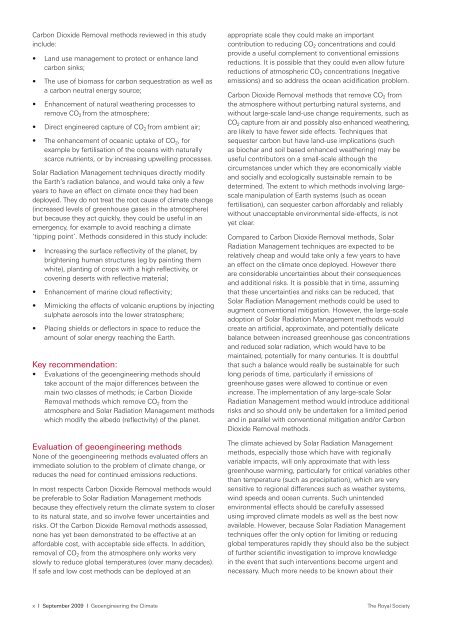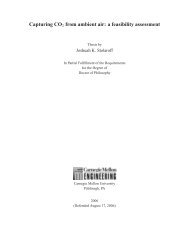Royal Society - David Keith
Royal Society - David Keith
Royal Society - David Keith
You also want an ePaper? Increase the reach of your titles
YUMPU automatically turns print PDFs into web optimized ePapers that Google loves.
Carbon Dioxide Removal methods reviewed in this study<br />
include:<br />
• Land use management to protect or enhance land<br />
carbon sinks;<br />
• The use of biomass for carbon sequestration as well as<br />
a carbon neutral energy source;<br />
• Enhancement of natural weathering processes to<br />
remove CO 2 from the atmosphere;<br />
• Direct engineered capture of CO2 from ambient air;<br />
• The enhancement of oceanic uptake of CO2, for<br />
example by fertilisation of the oceans with naturally<br />
scarce nutrients, or by increasing upwelling processes.<br />
Solar Radiation Management techniques directly modify<br />
the Earth’s radiation balance, and would take only a few<br />
years to have an effect on climate once they had been<br />
deployed. They do not treat the root cause of climate change<br />
(increased levels of greenhouse gases in the atmosphere)<br />
but because they act quickly, they could be useful in an<br />
emergency, for example to avoid reaching a climate<br />
‘tipping point’. Methods considered in this study include:<br />
• Increasing the surface reflectivity of the planet, by<br />
brightening human structures (eg by painting them<br />
white), planting of crops with a high reflectivity, or<br />
covering deserts with reflective material;<br />
• Enhancement of marine cloud reflectivity;<br />
• Mimicking the effects of volcanic eruptions by injecting<br />
sulphate aerosols into the lower stratosphere;<br />
• Placing shields or deflectors in space to reduce the<br />
amount of solar energy reaching the Earth.<br />
Key recommendation:<br />
• Evaluations of the geoengineering methods should<br />
take account of the major differences between the<br />
main two classes of methods; ie Carbon Dioxide<br />
Removal methods which remove CO 2 from the<br />
atmosphere and Solar Radiation Management methods<br />
which modify the albedo (reflectivity) of the planet.<br />
Evaluation of geoengineering methods<br />
None of the geoengineering methods evaluated offers an<br />
immediate solution to the problem of climate change, or<br />
reduces the need for continued emissions reductions.<br />
In most respects Carbon Dioxide Removal methods would<br />
be preferable to Solar Radiation Management methods<br />
because they effectively return the climate system to closer<br />
to its natural state, and so involve fewer uncertainties and<br />
risks. Of the Carbon Dioxide Removal methods assessed,<br />
none has yet been demonstrated to be effective at an<br />
affordable cost, with acceptable side effects. In addition,<br />
removal of CO 2 from the atmosphere only works very<br />
slowly to reduce global temperatures (over many decades).<br />
If safe and low cost methods can be deployed at an<br />
appropriate scale they could make an important<br />
contribution to reducing CO 2 concentrations and could<br />
provide a useful complement to conventional emissions<br />
reductions. It is possible that they could even allow future<br />
reductions of atmospheric CO 2 concentrations (negative<br />
emissions) and so address the ocean acidification problem.<br />
Carbon Dioxide Removal methods that remove CO 2 from<br />
the atmosphere without perturbing natural systems, and<br />
without large-scale land-use change requirements, such as<br />
CO 2 capture from air and possibly also enhanced weathering,<br />
are likely to have fewer side effects. Techniques that<br />
sequester carbon but have land-use implications (such<br />
as biochar and soil based enhanced weathering) may be<br />
useful contributors on a small-scale although the<br />
circumstances under which they are economically viable<br />
and socially and ecologically sustainable remain to be<br />
determined. The extent to which methods involving largescale<br />
manipulation of Earth systems (such as ocean<br />
fertilisation), can sequester carbon affordably and reliably<br />
without unacceptable environmental side-effects, is not<br />
yet clear.<br />
Compared to Carbon Dioxide Removal methods, Solar<br />
Radiation Management techniques are expected to be<br />
relatively cheap and would take only a few years to have<br />
an effect on the climate once deployed. However there<br />
are considerable uncertainties about their consequences<br />
and additional risks. It is possible that in time, assuming<br />
that these uncertainties and risks can be reduced, that<br />
Solar Radiation Management methods could be used to<br />
augment conventional mitigation. However, the large-scale<br />
adoption of Solar Radiation Management methods would<br />
create an artificial, approximate, and potentially delicate<br />
balance between increased greenhouse gas concentrations<br />
and reduced solar radiation, which would have to be<br />
maintained, potentially for many centuries. It is doubtful<br />
that such a balance would really be sustainable for such<br />
long periods of time, particularly if emissions of<br />
greenhouse gases were allowed to continue or even<br />
increase. The implementation of any large-scale Solar<br />
Radiation Management method would introduce additional<br />
risks and so should only be undertaken for a limited period<br />
and in parallel with conventional mitigation and/or Carbon<br />
Dioxide Removal methods.<br />
The climate achieved by Solar Radiation Management<br />
methods, especially those which have with regionally<br />
variable impacts, will only approximate that with less<br />
greenhouse warming, particularly for critical variables other<br />
than temperature (such as precipitation), which are very<br />
sensitive to regional differences such as weather systems,<br />
wind speeds and ocean currents. Such unintended<br />
environmental effects should be carefully assessed<br />
using improved climate models as well as the best now<br />
available. However, because Solar Radiation Management<br />
techniques offer the only option for limiting or reducing<br />
global temperatures rapidly they should also be the subject<br />
of further scientific investigation to improve knowledge<br />
in the event that such interventions become urgent and<br />
necessary. Much more needs to be known about their<br />
x I September 2009 I Geoengineering the Climate<br />
The <strong>Royal</strong> <strong>Society</strong>








